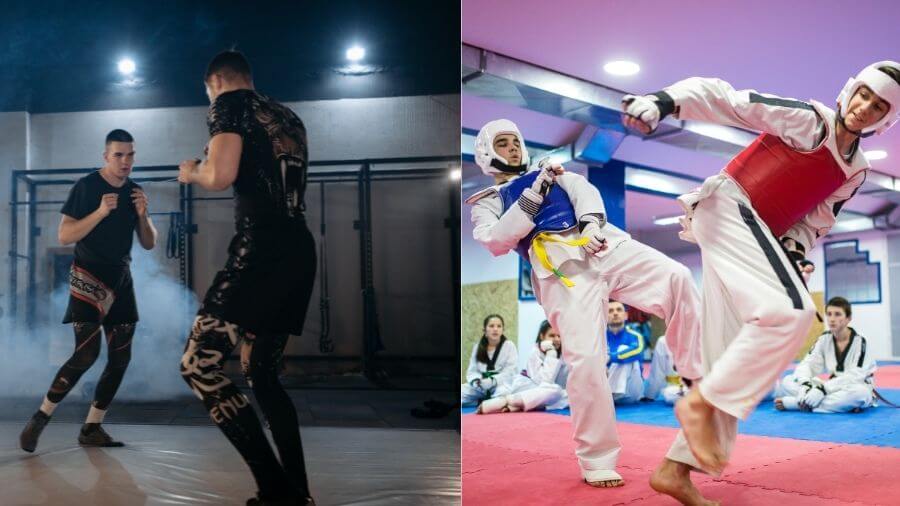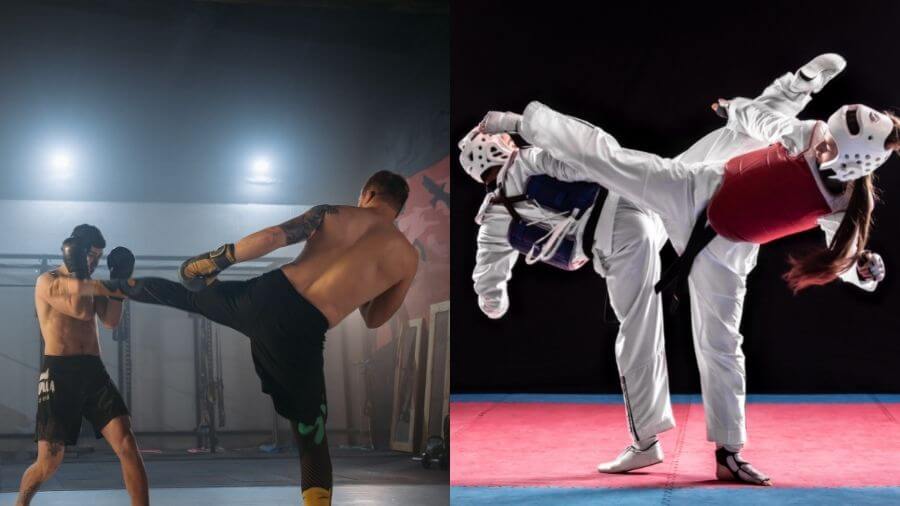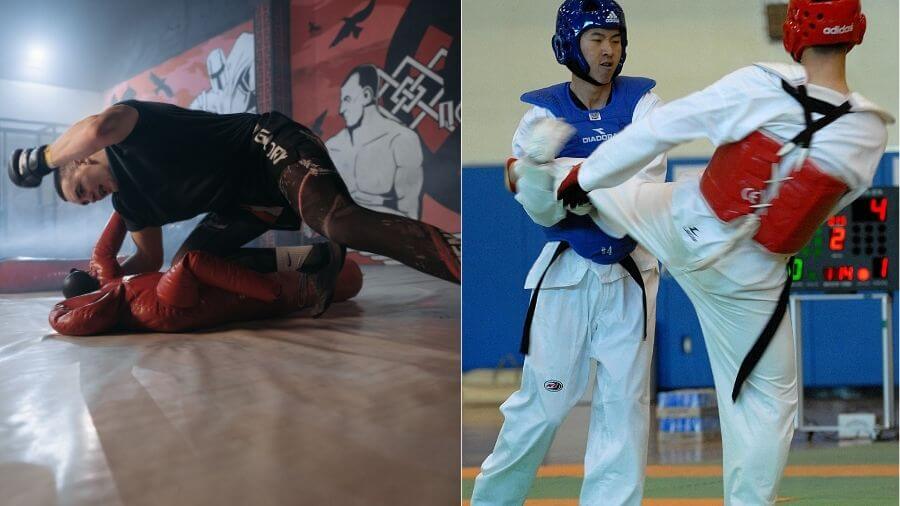One of the few traditional martial arts that have found a place in MMA is Taekwondo. Kicks are an integral part of MMA, and the Korean martial art is solely focused on kicking, which makes it an excellent base to build on in MMA.
But in a direct fight, MMA obliterates Taekwondo. The narrow focus of Taekwondo leaves too many gaps that any MMA fighter can easily exploit. Sports Taekwondo especially has very little realism, and it is no match for MMA in a direct fight.
Let’s see how the two styles stack up against each other in every aspect.
What Is MMA?
MMA is an abbreviation for Mixed Martial Arts. MMA is a combat sport that allows striking with hands, legs, elbows, knees, wrestling, joint locks, strangulations, and other submissions and striking on the ground. This broad ruleset takes techniques from all martial arts. It stirs them up into a concoction of technical and tactical violence.
In the 20th century, mixed-rules fights were gradually making their way into the forefront until, in 1993, the first UFC was held. The “anything goes” fighting captivated audiences but also repelled many others for the unfiltered brutality it offered.
In less than 10 years, the UFC and MMA, in general, have evolved into regulated athletic contests while still maintaining a lot of authenticity. Today, MMA is the fastest growing sport globally, with billions of dollars in revenue, millions of fans around the world, and fighters that have become worldwide celebrities.
What Is Taekwondo?
The name roughly means “the foot and fist way.” Taekwondo is, in fact, a kicking martial art that heavily favors kicks and only allows some light contact punches. Taekwondo is characterized by lightning-fast kicks and many flashy and spinning techniques.
The origins of the Korean martial art can be traced back to ancient times in its earliest names, “Subak” and “Taekkyon.” Like their neighbors in China and Japan, martial arts in Korea were an essential part of the culture.

How to Dominate Every Fight with Raw, Explosive Power No One Can Match
Discover the underground blueprint that has quietly turned MMA hopefuls into legends, using nothing but sheer, brute force and bulletproof conditioning techniques.
They were developed with varying intensity throughout their entire history. The modern martial art of Taekwondo was created in 1959 by the joint effort of teachers of traditional Korean martial arts to create a unified system for the whole country.
Their attempt was short-lived, and in 1966, Taekwondo was split due to internal disagreements, and the ITF was created. The main branch of today’s sport is the WTF, also known as sports or Olympic Taekwondo.
Since its establishment in 1973, it has gathered enormous worldwide popularity. Its inception in the 1988 Olympics further boosted it as a demonstration and as an official sport in 2000.
The WTF version of competition is strictly regulated (as is any Olympic sport). The main point of the match is to score points by kicking. Head kicks score higher than body kicks, and spinning kicks score higher than normal ones.
Punches to the head are not allowed, only to the body protector. Taekwondo matches are fast-paced, rapid kicks are exchanged, and dodging is the primary means of defense.
Key Differences Between MMA And Taekwondo

Rules
The rules are the most significant difference between the two disciplines, and they determine much of the rest. MMA is the most unrestricted type of combat sport, allowing fighting in all domains of unarmed combat- striking, wrestling, and grappling.
The goal of the fight is to knockout or submit the opponent. In case it doesn’t happen, the winner is decided by the judges scoring the match based on different criteria.
Taekwondo, as we’ve said, has two main branches. The WTF and the ITF. WTF is the Olympic version and by far the most popular one. There, kicks are allowed to the head and torso (no low kicks), and punches are permitted only to the body.
ITF style offers a bit more realism and allows punches to the head. The scoring system heavily favors kicks, so they remain the focus, but punches are still used. On the other hand, sparring and competition under ITF rules often only permit light contact. At the same time, WTF allows full contact for the legal strikes.
Equipment
MMA fighters wear 4-ounce gloves without fingers to better facilitate grappling. Outside of that, the only other protection used is mouth and groin guards. The fighting “uniform” consists of MMA shorts for men and shorts and some tops for the ladies.
WTF Taekwondo athletes wear head guards, forearm guards, shin guards, a protective vest, and very thin gloves (there are no punches anyway). ITF taekwondo has similar defensive gear but without the chest guard.
Taekwondo has always been practiced in a traditional uniform called a “dobok,” consisting of a jacket, trousers, and belt.
Techniques
The philosophy of MMA is to take and use everything that shows worth in the cage. So, the meta of MMA is constantly evolving. Techniques that were once thought worthless suddenly become widely used once a fighter finds a way to use them effectively. And naturally, taekwondo kicks are also frequently used in MMA.
Taekwondo is almost entirely kicking, including every imaginable kick to the permitted target. Roundhouse kicks, sidekicks, front kicks, hook kicks, axe kicks, spinning kicks, hurricane kicks, and much more.
Philosophy And Teaching
A considerable difference between MMA and all traditional martial arts is the philosophy and teaching method.
Taekwondo has a set systematic approach taught through a uniform curriculum in every school under one federation. This means that you will be taught roughly the same way wherever you train. It also has an underlying philosophical principle known as the Five Tenets of Taekwondo. These are courtesy, integrity, perseverance, self-control, and indomitable spirit.
On the other hand, MMA does not have any of these. It is up to each coach and academy to decide which values to instill in their students and what methodology to use in training.
MMA vs. Taekwondo For Self Defense

It’s safe to conclude that MMA is immeasurably superior for self-defense to Taekwondo. While MMA still has rules that make it very different from an actual street fight, it prepares you for all aspects of fighting.
Furthermore, the sport’s violent nature conditions the body and mind to at least some level of actual physical confrontation.
Kicks may be very powerful, but they require a specific range to work, and on the street, this range is often severely lacking. In a direct fight, a taekwondo practitioner will suffer defeat at the hand of another trained individual regardless of whether he prefers striking or grappling.
Taekwondo has a much better chance against an untrained aggressor. The agility and speed will catch an unprepared person off guard.
Is Taekwondo Effective In MMA?
The above point does not mean that Taekwondo is ineffective – only that it is when it’s used without any other skills and abilities. Taekwondo serves as a wonderful base to step upon and develop as an MMA fighter.
The insane levels of athleticism required to compete in Taekwondo can accommodate all other skills that a fighter develops when he starts training in different disciplines.
Like many other traditional martial arts, Taekwondo teaches personal and mental traits that are somewhat missing in fighters without a traditional background. This shouldn’t be overlooked when we evaluate the effectiveness of Taekwondo for MMA.
Kicking is an integral part of MMA, and you could argue that taekwondo guys are the best kickers. They have the widest variety of fast, snappy kicks like karate guys and hard kicks like Muay Thai fighters. These are combined with accuracy, flexibility, and precision.
You get an extremely dangerous fighter when you start enhancing these things with boxing and wrestling competency and learn to manage the different fighting ranges.
And let’s not forget that if there is one thing the MMA public, promoters, and sponsors love more than exciting fights, it’s exciting finishes. And few things can rival flashy kick knockouts, which are the specialty of taekwondo fighters.
Do Any MMA Fighters Use Taekwondo?

All of the above has been proven by many prominent MMA fighters. Quite a few had black belts in Taekwondo before going into MMA, like Bas Ruten, Benson Henderson, Anderson Silva, and Valentina Shevchenko, among many others.
They showcase their taekwondo background from time to time in the octagon, but there are a few fighters who remain even more loyal to their base art. Yair Rodriguez is the best example of a fighter who upgraded his taekwondo skillset with skills from other arts but still centers his entire game around kicking.
Another walking highlight reel of flashy kicks is the former UFC lightweight champion, Anthony Pettis. Watching him fight, especially early in his career, you can immediately see what his base was.
MMA vs. Taekwondo – Who Would Win?
A pure taekwondo practitioner cannot defend punches, takedowns, or submissions. Even the base stance of Taekwondo with hands below the waist will make him easy prey for a blitz of punches or a powerful double leg takedown. Plenty of online videos demonstrates what happens when a pure taekwondo fighter faces another martial artist under MMA or even K1 kickboxing rules.
Should You Do MMA or Taekwondo?
As always, the answer lies in your own goals and preferences. Taekwondo carries all the benefits of traditional martial arts teaching and philosophy. Still, it also comes with the downside, which is a severe lack of realism in fighting.
MMA, on the other hand, is extremely efficient. Still, it’s also violent, brutal, and taxing on the body, even if trained without competing. An excellent formula is to start with Taekwondo as a kid and then transition to MMA after establishing a strong base. Taekwondo is fantastic for kids, and it’s easy to see why it has millions of practitioners. But if you want to have some real fighting skills, you better go with MMA.

